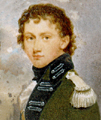 |

1. Gesture and Figure
|
 |


1. GESTURE AND FIGURE
Symbolic:
 |
 |

Draft of
George Washington’s
Farewell Address
Library of Congress
|
Some think that Washington is pointing toward the future, foreseeing bright prospects for his nation. Others believe that Washington is saying farewell. When this portrait was painted, he was about to leave office after having served two terms as President. Viewing the portrait, an observer saw him “bestowing his good advice to his countrymen.” Others have inferred that the painting commemorates the recent signing and ratification of Jay’s Treaty.
 |
 |

Lord John Fitzgibbon by Gilbert Stuart, oil on canvas, 1789
The Cleveland Museum
of Art
|
Washington is, by one appraisal, a “paragon of virtue and, as such, a source of national pride and inspiration.” His dignified stance lends a regal air to the portrait, calling to mind contemporary portraits of royal and noble figures of the day in England and Europe but also a strength and simplicity fit for a leader of a new republic.
Biographic:
 |
 |

John Jay by Gilbert Stuart and John Trumbull, oil on canvas, begun in 1784; completed in 1818
National Portrait Gallery, Smithsonian Institution
|
Washington is about to retire from government service, saying “no consideration under heaven that I can foresee shall again draw me from the walks of private life.” His recent months have not been tranquil. In a rare display of partisanship, he has fought against opponents of Jay’s Treaty, which settled several issues left unresolved by the 1783 treaty that ended the Revolutionary War. John Jay negotiated the treaty that bears his name; coincidentally, Jay also introduced painter Gilbert Stuart to President Washington.
 |
 |

Washington’s Farewell Address, printed in Claypool’s American
Daily Advertiser,
September 19, 1796
The Gilder Lehrman Collection, on deposit at
The Pierpont Morgan Library, GLC 185
|
Soon Washington’s countrymen will read his Farewell Address, which he did not deliver in person. It appeared first in a newspaper on September 19, 1796. In it, he warned of the dangers of forming permanent foreign alliances and of the divisiveness of political parties.
 |
 |

Washington, Lafayette and Tilghman at Yorktown, by Charles Wilson Peale, oil on canvas, 1784
Maryland Commission on Artistic Property of the Maryland State Archives
|
Contemporaries said Washington had the stature of a king. Standing more than six feet tall, he towered over most of his fellow citizens. Benjamin Rush, a prominent Philadelphia physician, said of Washington, “There is not a king in Europe that would not look like a valet de chambre by his side.”
 |
 |

View of Mount Vernon, attributed to Edward Savage, oil on canvas, circa 1792
The Mount Vernon
Ladies’ Association
|
When Gilbert Stuart painted this portrait, Washington was 64 years old and looking forward to retirement at Mount Vernon. He had felt the same way after the Revolutionary War, when he said he wanted to follow the example of the Roman citizen-soldier Lucius Quinctius Cincinnatus, and live “under my own Vine and my own Fig-tree, free from the bustle of a camp and the intrigues of a court.” But his postwar wish to “glide gently down the stream of life” was not to be. Now, in 1796, he is finally going to get his wish. But his retirement will be tragically short: He will die at Mount Vernon in 1799.
Artistic:
 |
 |

Painter and President by Jean Leon Gerome Ferris
National Museum of American History, Smithsonian Institution, Behring Center
|
Gilbert Stuart knew that Washington lacked time and patience for posing. There is no record of how many times Washington posed for the portrait, but typically there would have been at least three sessions, each lasting about two hours. The artist usually devoted what time he had to focusing on the subject’s face and perhaps the hands. A talented artist like Stuart could paint the rest from his imagination or from a discreetly recruited model. Stuart had painted bust-length portraits of Washington twice before, but the portrait painted for the Marquis of Lansdowne was the artist’s first full-length portrait of the President.
 |
 |

Marble Statue of George Washington by Jean-Antoine Houdon, circa 1794
State Capital, Commonwealth of Virginia, Library of Virginia
|
For Washington’s body, Stuart used at least one stand-in. Contemporary accounts name three men who may have posed in Washington’s place: W. Moore Smith, in whose house Stuart painted the portrait; Michael Keppele, a Philadelphia alderman (whose daughter made the claim); and the Comte de Noailles, a friend of Stuart’s.
 |
 |

George Washington Parke Custis by Robert Field, miniature watercolor
on ivory, 1804
Virginia Historical Society
|
Stuart may have used a wax cast of his own hands as a model for Washington’s hands. Washington’s grandson, George Washington Parke Custis, said that “the hands were painted from a wax cast of Stuart’s own hand, which was much smaller than Washington’s.”
 |
 |

Gilbert Stuart by an unidentified artist,
oil on wood
National Portrait Gallery, Smithsonian Institution
|
“Look at my hand,” Stuart once said. “See how the colours are mottled and mingled. . . good flesh colouring partook of all colours, not mixed, so as to be combined in one tint, but shining through each other, like the blood through the natural skin.”
|




